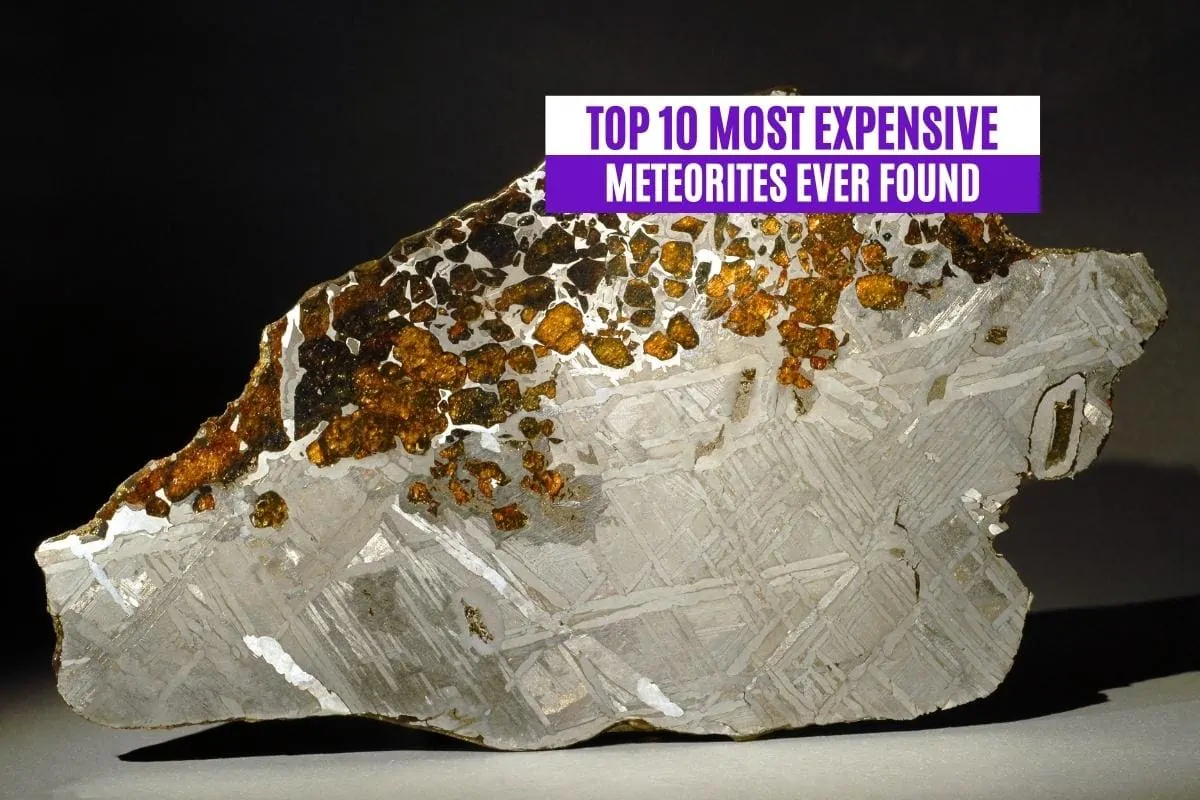Meteorites are rocks that fall from space, through the planet’s atmosphere, and land on the ground. The chance of space rocks surviving the harsh temperature changes and pressure as it passes through the atmosphere is slight, so meteorites are a rare material. However, space rocks lucky enough to land intact can fetch incredible prices!
The most expensive meteorite ever found is the Fukang Meteorite. This massive lump of space rock is about 4.5 billion years old and weighs an incredible 2,211lbs (1,003kg). The largest chunk cut off from the main structure is valued at $2 million and contains olivine gemstones.
If you’re interested in owning one of the costliest hunks of meteorite ever discovered (or learn more about the priciest space rocks), this ranking will introduce you to a handful of top-notch options.
Here Are the Top 10 Most Expensive Meteorites Ever Found:
- The Main Mass of the Fukang Meteorite – $2 million
- The Willamette Meteorite’s Crown Section – $1.3 million
- Conception Junction Meteorite – $850,000
- Slice of the Fukang Meteorite – $721,552
- Brenham Meteorite Main Mass – $700,000
- NWA 11789 Lunar Meteorite – $612,500
- The Springwater Meteorite – $600,000
- Tisserlitine 001 Meteorite – $525,000
- The Gibeon Meteorite – $437,500
- Select Gibeon Meteorite – $300,000
10. Select Gibeon Meteorite – $300,000
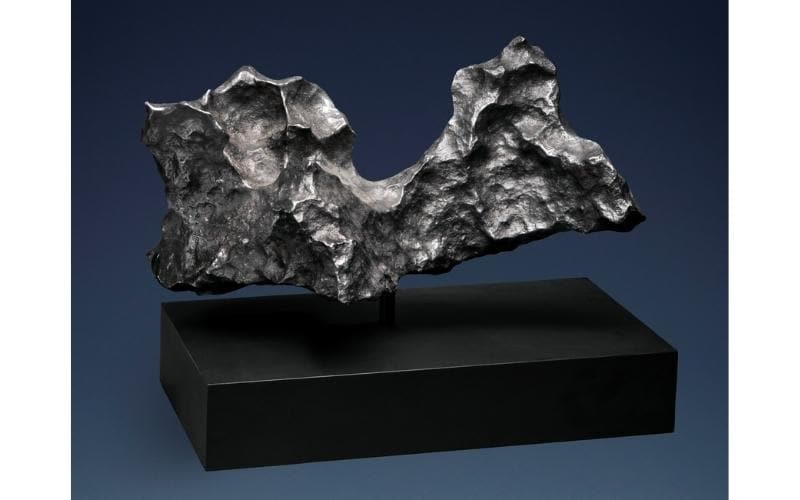
This Namibian meteorite has a silvery appearance reminiscent of pocked aluminum. But unlike aluminum, this meteorite wasn’t excavated from the Earth’s depths. Instead, it fell from the skies, landing in the massive Kalahari Desert.
When the Select Gibeon Meteorite went to auction in 2021, auctioneers estimated it might sell for only $100,000. But bidders competed for the chance to bring this unique hunk of space rock home, eventually driving the price upward to an impressive $300,000.
Why It’s Expensive
One of the primary reasons why the Select Gibeon Meteorite is expensive is its size. This massive sculptural meteorite weighs an impressive 117lbs (about 53kg), making it far larger than the tiny chunks of space rock available from online retailers like Etsy.
This rock is also mounted to a large stand, making it display-ready. Compare this to other meteorites, which are unadorned and supported (and, consequently, more affordable).
9. The Gibeon Meteorite – $437,500
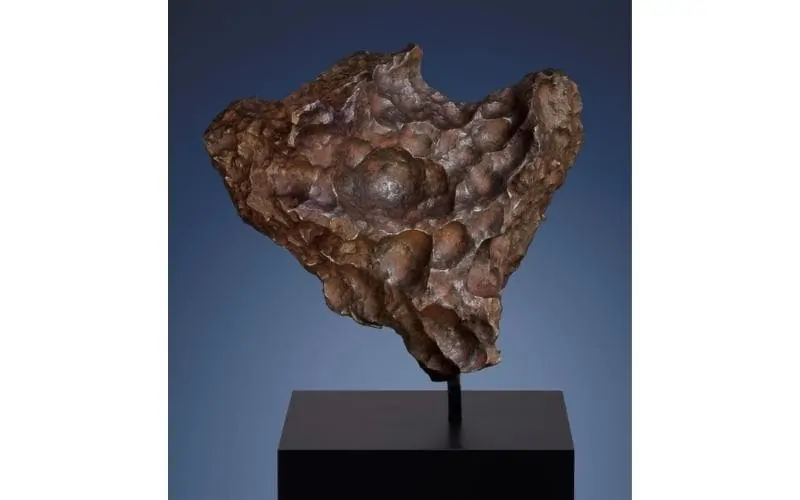
The Select Gibeon Meteorite isn’t the only Namibian space rock to sell at a high price. The aptly-named Gibeon Meteorite also fetched a reasonably steep price when it sold at auction in 2021—$437,500!
Still, this meteorite is theorized to be about as old as the Earth, with a prospective age of 4.5 billion years. Moreover, its aged, rust-like appearance has visible pockmarks, indicating impacts that happened long before the dinosaurs walked the planet.
Why It’s Expensive
The Gibeon Meteorite might not be as classically attractive as the Select Gibeon Meteorite, but it’s display-ready and incredibly hefty. This massive stone weighs 307lbs (about 140kg), making it one of the largest intact Namibian meteorites ever sold at auction.
Additionally, this meteorite could be up to 4.5 billion years old, making it about as old as the Earth itself! As such, it’s a historically significant piece that would look just at home in a museum as it would in an opulent mansion study.
8. Tisserlitine 001 Meteorite – $525,000
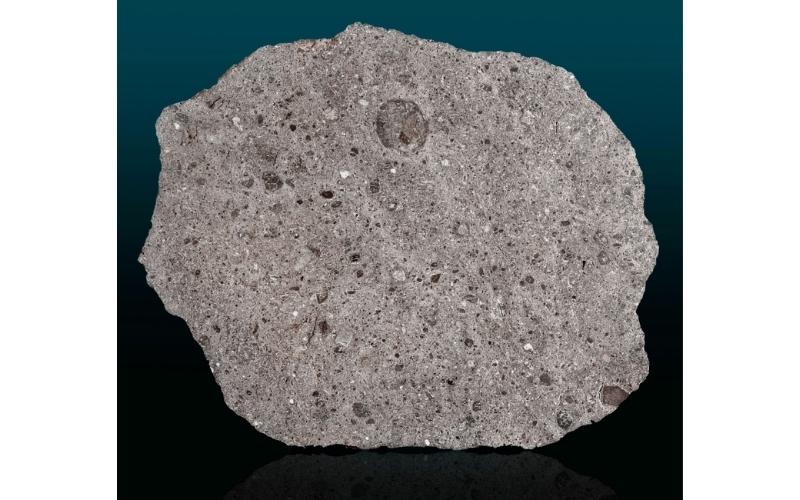
The name of this meteorite might not roll off the tongue, but its appearance is striking. Though easily mistaken for an old hunk of concrete, this rock is actually a broken-off piece of the Earth’s only satellite, the moon.
These are the only pieces of the moon available to buyers, as rocks collected during space missions are kept for scientific research and museum exhibits.
The Tisserlitine 001 Meteorite might only weigh about 4.33lbs (1.99kg), but it’s one of the largest pieces of lunar meteorite ever recovered. So it’s no surprise that this unique moon meteorite sold for $525,000 when it went to auction in 2021.
Why It’s Expensive
This meteorite is one of the largest pieces (the fourth-largest to be precise) of the moon to ever land on Earth. Though it might not be as large as the Namibian meteorites we’ve discussed, the fact that it’s both a moon rock and a meteorite makes it incredibly rare and valuable.
Anyone hoping to gift their loved one a piece of the moon (a satellite often associated with romance) would be wise to set their sights on acquiring a tiny bit of the existing 750kg (about 1,654lbs) moon meteorites found around the globe.
7. The Springwater Meteorite – $600,000
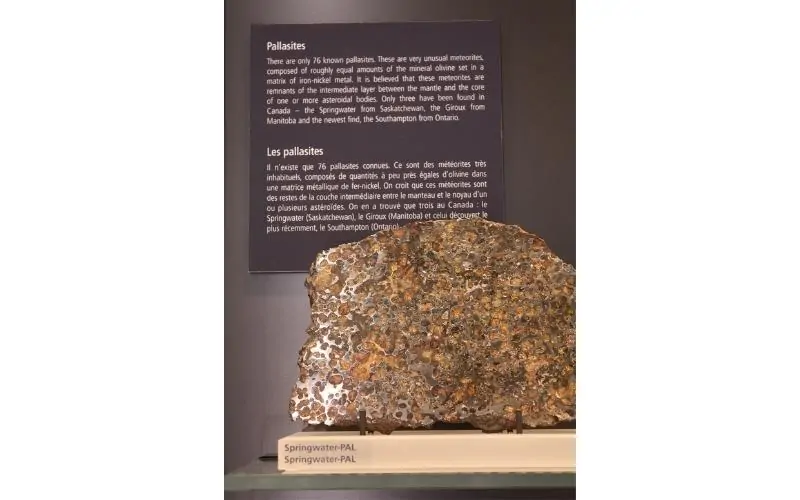
The Springwater Meteorite is a stony-iron pallasite meteorite that consisted of three large masses when it was discovered near Springwater, Saskatchewan in 1931, with the largest weighing 85lbs (38.6kg). But in 2009, an even more massive piece was found, and this chunk weighed 117lbs (53kg). The total known weight (TKW) of the Springwater Meteorite is 266lbs (120kg).
This final bit now sits inside the Royal Ontario Museum. The museum paid a whopping $600,000 for this incredible space rock, making it one of the most expensive meteorites in the world!
Why It’s Expensive
The Springwater Meteorite is the largest pallasite meteorite ever discovered in Canada. As such, it’s a record-breaking, historically-significant space rock. These qualities make it more valuable than other types of meteorites.
The olivine crystals embedded in this meteorite also add to its value. After all, olivine is the primary component in precious gemstones like peridot.
6. NWA 11789 Lunar Meteorite – $612,500
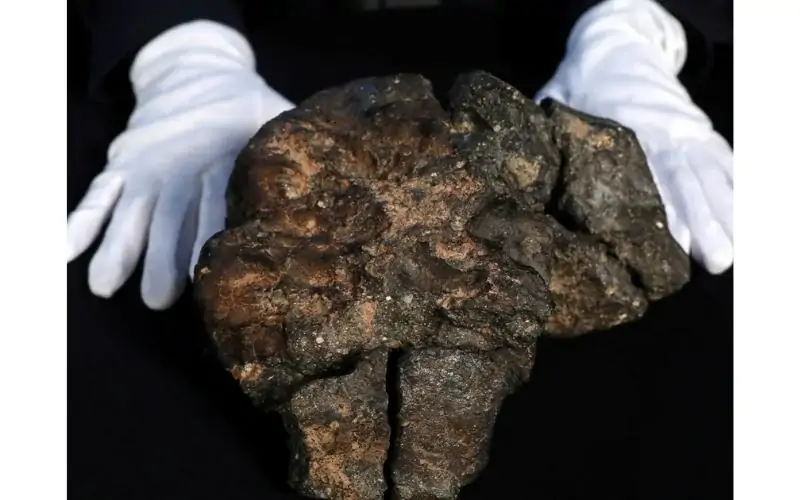
The NWA 11789 Lunar Meteorite (often called The Moon Puzzle) is a piece of the moon that separated into six pieces due to the incredible impact received after falling to Earth. Fortunately, the pieces weren’t scattered far, allowing curators to reassemble them into a single, distinct rock.
When this fragmented moon meteorite went to auction in 2018, its $612,500 final big shocked the previous owner, Dustin Dickens. But there aren’t many opportunities to own a piece of the moon, as only a few moon meteorites have survived their plummet through Earth’s atmosphere. So, the sales price is right on the money.
Why It’s Expensive
Like the Tisserlitine 001 Meteorite, the NWA 11789 Lunar Meteorite is a piece of the moon. An asteroid impact likely knocked this chunk of the moon toward the Earth.
Many moon meteorites burn into a fine powder when falling to the Earth, so they’re exceptionally rare. However, this specimen also shows evidence of high temperatures experienced while falling through the atmosphere at high speeds, making it a scientific treasure and a surefire conversation starter.
Though this isn’t the largest lunar meteorite ever found, it does have a unique appearance and story that helps make it a precious discovery.
5. Brenham Meteorite Main Mass – $700,000
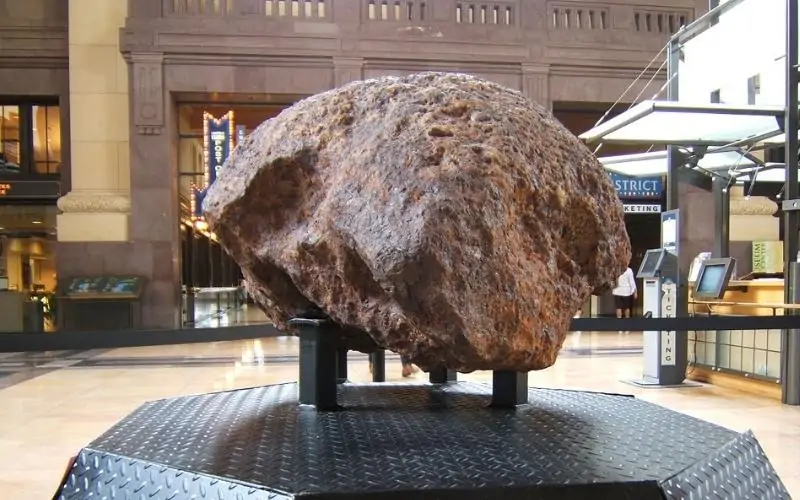
The Brenham Meteorite Main Mass is a dome-shaped rock discovered in Kansas in 1949. For several decades, this space rock was known as the world’s largest pallasite meteorite, weighing 1,410lbs (about 641kg).
It’s also one of the priciest, selling in 2007 for $700,000. Like other pallasite meteorites, this specimen contains olivine crystals. These crystals can eventually adhere together to form peridot.
Why It’s Expensive
This meteorite might not appeal to those with trypophobia (fear of holes), but it will interest anyone hoping to own extraterrestrial gemstones. After all, the Brenham Meteorite Main Mass contains a dazzling array of peridot stones formed in outer space.
This chunk of space stone is also one of the world’s largest pieces of pallasite meteorite, making it a natural collectible for affluent buyers with a passion for astronomy, geology, and historical artifacts.
4. Slice of the Fukang Meteorite – $721,552
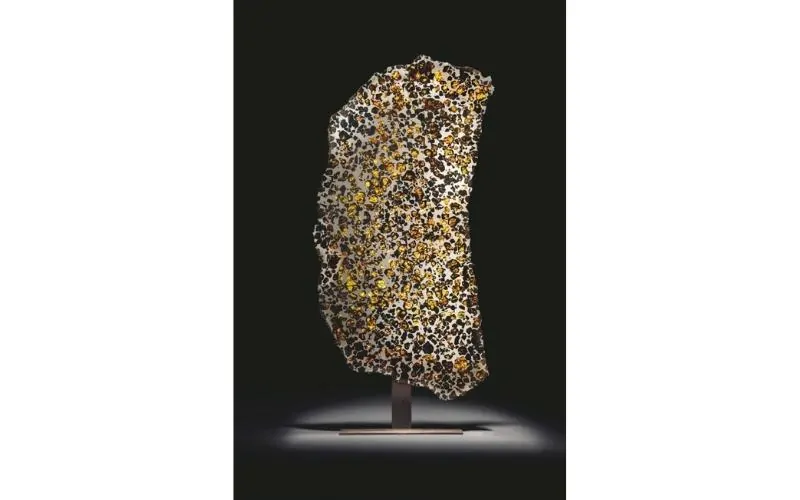
The Fukang Meteorite isn’t the largest ever discovered, but it is the most massive hunk of pallasite meteorite on the planet. It’s also a stunning rock filled with ovaline crystals and peridot stones. In fact, this meteorite contains more ovaline crystals than any other known meteorite.
The Slice of the Fukang Meteorite weighs 18lbs (8.15kg), but it’s far pricier than other meteorites of the same size because this amazing meteorite contains some of the largest and most translucent crystals of any pallasite. When it went to auction in 2021, it sold for $721,552.
Why It’s Expensive
The Fukang Meteorite is world-famous due to its incredible size and hex-like structure (filled with peridot). As such, the demand to own a piece of the original rock is incredibly high, but supply is very limited.
This relationship between supply and demand makes it far more costly than other space rocks.
3. Conception Junction Meteorite – $850,000
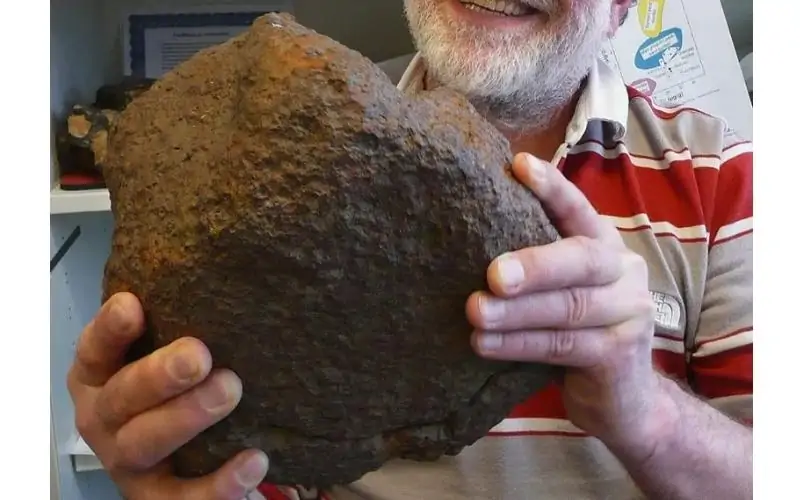
While African meteorites might be more plentiful, the rare few found in North America can fetch incredible prices. That’s certainly true of the Conception Junction Meteorite, so-named due to its discovery at Conception Junction, Missouri.
This pallasite meteorite was discovered in 2016 and was initially worth $850,000. However, the 37-pound (17kg) space rock was split into smaller pieces, making it more affordable to everyday buyers.
Why It’s Expensive
The Conception Junction Meteorite is considered one of the most attractive and valuable space rocks due to its unique milky white and brown color and the high number of peridot gemstones inside the rock. But this isn’t the priciest pallasite meteorite in the world!
2. The Willamette Meteorite’s Crown Section – $1.3 Million
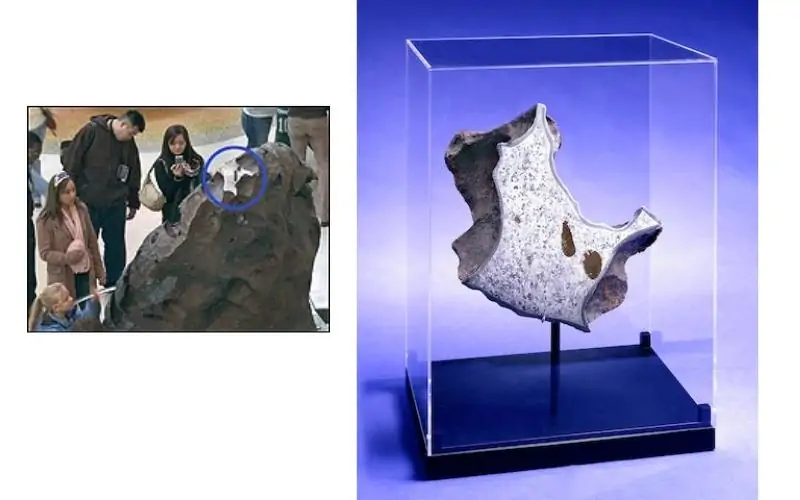
The first time you look at the Willamette Meteorite (also called Tomanowos), you might think it’s a massive handmade sculpture. But its unearthly appearance isn’t the result of hardworking human hands.
Instead, its deep grooves and massive pockets result from asteroid impacts and a heavy fall to Earth! Though this incredible specimen is on display at the American Museum of Natural History in New York, New York, a small chunk (the crown section of the Willamette Meteorite) weighing 29.5lbs (13.4kg) sold in 2007 for $1.3 million.
Why It’s Expensive
The original Willamette Meteorite is a national treasure and is the largest meteorite ever discovered in the United States. It was also prized by native peoples, most notably the Clackamas tribe.
All told, this incredible piece is the sixth-largest meteorite ever discovered, making it almost priceless. The opportunity to own even a small portion is incredibly limited, so when a tiny chunk went to auction, it naturally sold for an equally incredible price.
1. The Main Mass of the Fukang Meteorite – $2 Million
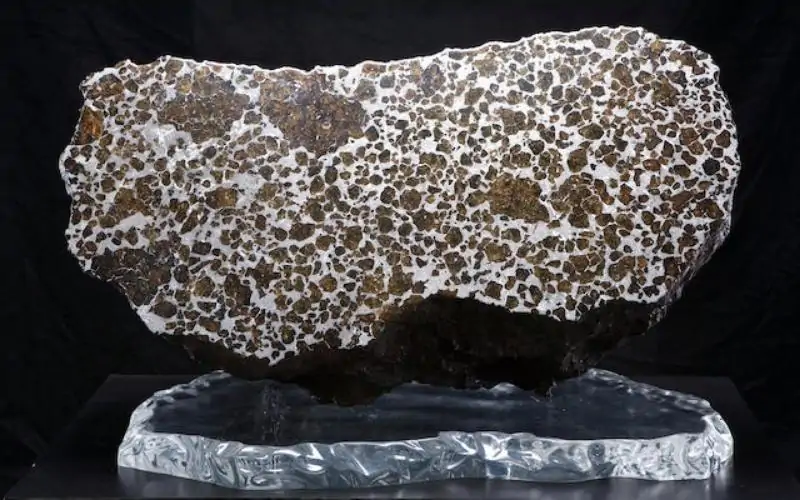
The most expensive meteorite ever found is the Fukang Meteorite. In 2000, a meteorite dealer in China received an incredible specimen—a one-ton hunk of meteorite with a distinctly high number of olivine crystals and peridot stones. This hunk was found in the mountains near Fukang, China and soon separated into smaller pieces, including this remarkable chunk which is the main mass of the Fukang Meteorite (925lbs) valued at $2 million.
Though this space stone’s uniqueness and value are undeniable, it remains unsold. So, if you’d like to become the owner of the world’s most valuable space rock, you might want to contact Bonhams in New York.
Why It’s Expensive
The Fukang Meteorite may be the largest pallasite meteorite on the planet, with a reputed original weight of 2,211lbs (1,003kg). Moreover, small portions cut from this legendary space rock are usually rich in peridot, adding to its enigmatic nature and allure.
It’s also believed that this meteorite is about as old as Earth, with an estimated age of 4.5 billion years. These qualities combine to make the Fukang Meteorite one of the most desirable specimens available to wealthy collectors, increasing its value.
Why Are Some Meteorites So Expensive?
Meteorites may not be as common as plastics or well-known metals (like aluminum and steel), but they’ve seen an increase in demand over the last several decades. For example, meteorite has quickly become a popular alternative to gold for those looking to own unique wedding rings.
But while a ring made from meteorite might cost up to $4,000, several of the meteorites on this ranking dwarf that price by thousands (or millions) of dollars. So, why are some meteorites so expensive?
Generally, the costliest meteorites are massive, aesthetically attractive, and historically significant rocks. As such, the qualities that influence meteorite pricing include:
- Size
- Scarcity
- Aesthetic appeal
- Mineral composition
- Historical significance
Let’s take a moment to explore these factors. After all, when you know what makes some meteorites costly, you’ll be able to select a high-quality (and high-priced) space rock to suit your needs and preferences!
Size
The larger the meteorite, the more precious it is! After all, most meteors that enter the Earth’s atmosphere break up into tiny pieces due to the high speed, incredible pressure, and high temperatures experienced when falling toward the ground.
Those fortunate enough to discover large meteorites (those weighing several hundred pounds) can sell them for jaw-dropping prices. But the most expensive meteorites tend to be large and scarce, meaning they’re a rare type of meteorite.
Scarcity
Most meteors burn up before reaching the Earth’s surface, with only a tiny percentage becoming meteorites. As such, meteorites are far rarer than other types of rocks created by natural earth processes.
But there are several types of meteorites, and some are scarcer than others. For example, pallasite meteorites are the rarest, while ordinary chondrites (stony meteorites) are the most common. The former is often studded with gorgeous gems, while the latter looks like a dark chunk of stone.
If you’re hoping to own one of the most treasured space rocks, you’ll likely want to invest in an authentic pallasite meteorite. Besides, these jewel-studded rocks tend to be incredibly beautiful, making them ideal centerpieces or conversation starters.
Aesthetic Appeal
Like the world’s most expensive crystals, the priciest meteorites tend to be aesthetically appealing. This means that they’re desirable to buyers because of their appearance.
Meteorites with unique shapes or precious gemstones are often the most attractive. Still, beauty lies in the eye of the beholder! As such, meteorites that may be unattractive to some could look gorgeous to others.
That said, mineral composition influences meteorite price just as much as aesthetic appeal. Space rocks that have developed brilliant jewels are almost always pricier than those composed of iron and nickel.
Mineral Composition
Most meteorites have an unexciting mineral composition. They’re mostly made of nickel, iron, and sulfide.
But pallasite meteorites (the rarest kind) or meteorites that have been on Earth for prolonged periods often contain precious jewels. Many scientists believe that the glossy green-yellow stones inside pallasite meteorites formed in outer space, making them the only non-terrestrial gemstones ever discovered.
Historical Significance
The final factor influencing a meteorite’s price is historical significance. For example, the meteorite dagger found in Tutankhamun’s tomb is a priceless artifact due to its history and material.
The most historically significant meteorite might be the one theorized to kill the dinosaurs (potentially landing near the Yucatán peninsula). Geologists may have found small pieces of this world-changing rock as far north of the impact site as North Dakota, but these tiny bits are unavailable for sale (for now).
The Most Expensive Meteorite Ever Found
The most expensive meteorite ever found is the Fukang Meteorite, a rare pallasite meteorite. This massive 925lb (420kg) slab of space rock was removed from the original mass, which weighed an incredible 2,211-pound (1,003kg).
This meteorite is about 4.5 billion years old and has a honeycomb-like structure filled with olivine and peridot gems. As such, it’s one of the largest, rarest, oldest, and most mineral-rich meteorites on the planet, boosting its value to the $2 million mark.
Check out these articles for more information about the most expensive natural items!

